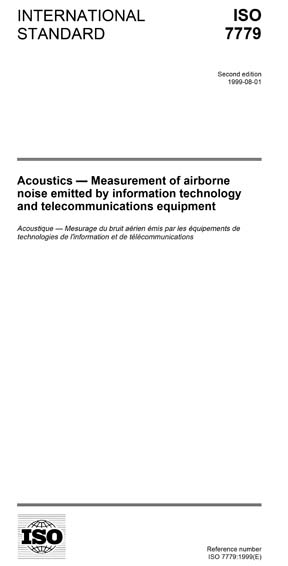Historical
ISO 7779:1999
Acoustics - Measurement of airborne noise emitted by information technology and telecommunications equipment
This International Standard specifies procedures for measuring and reporting the noise emission of information technology and telecommunications equipment. This standard is considered part of a noise test code for this type of equipment, and is based on basic noise emission standards ISO 3741, ISO 3744, ISO 3745 and ISO 11201. The basic emission quantity is the A-weighted sound power level which may be used for comparing equipment of the same type but from different manufacturers, or for comparing different equipment.
Three basic noise emission standards for determining the sound power levels are specified in this International Standard in order to avoid undue restriction on existing facilities and experience. The first basic standard (ISO 3741) specifies comparison measurements in a reverberation room; the other two (ISO 3744 and ISO 3745) specify measurements in an essentially free field over a reflecting plane. Any one of these three basic noise emission standards may be selected and shall then be used exclusively according to this International Standard when determining sound power levels of a machine.
The A-weighted sound power level is supplemented by the A-weighted sound pressure level measured at the operator position(s) or the bystander positions, based on the basic noise emission standard ISO 11201. This sound pressure level is not a worker's immission rating level, but it may assist in identifying any potential problems that could cause annoyance, activity interference, or hearing damage to operators and bystanders.
Methods for determining whether the noise emission includes prominent discrete tones or is impulsive in character are specified in annexes D and E respectively.
This International Standard is suitable for type tests and provides methods for manufacturers and testing laboratories to obtain comparable results.
The methods specified in this International Standard allow the determination of noise emission levels for a unit tested individually.
The procedures may be applied to equipment which emits broad-band noise, narrow-band noise and noise which contains discrete-frequency components, or impulsive noise.
The sound power and sound pressure levels obtained may serve noise emission declaration and comparison purposes (see ISO 9296). They are not to be considered as installation noise immission levels; however they may be used for installation planning (see ECMA TR/27).
If sound power levels obtained are determined for a number of units of the same production series, they can be used to determine a statistical value for that production series (ISO 9296).
Content Provider
International Organization for Standardization [iso]






